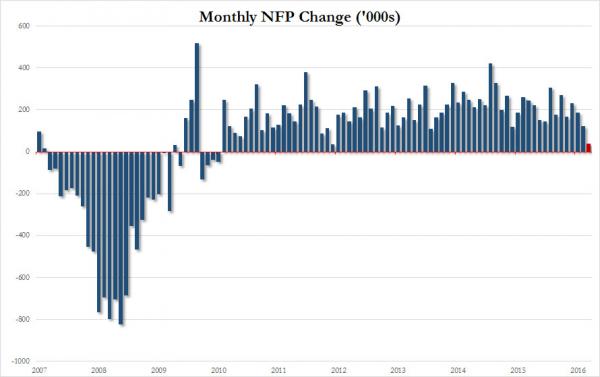Over the past few weeks we have spoken alot on the Fed’s use of public announcements by its cadre of regional Fed Presidents to try to sway markets into believing that the central bank was sure to hike interest rates in either June or July. And of course, inside most of this rhetoric is the single key component that is normally ignored by the computer algorithms that make up 75% of all trades, and that being the concept of data dependency.
Well in June 3, data dependency just went bye bye.
May’s non-farm payroll report just came out a couple hours ago, and it sent a shock through the entire financial system. That is because the report printed a jobs number of just 38,000 new hires, which is the lowest single month since the height of the Great Recession back in 2010.
If anyone was “worried” about the Verizon strike taking away 35,000 jobs from the pro forma whisper number of 200,000 with consensus expecting 160,000 jobs, or worried about a rate hike by the Fed any time soon, you can sweep all worries away: moments ago the BLS reported that in May a paltry 38,000 jobs were added, a plunge from last month’s downward revised 123K (was 160K).The number was the lowest since September 2010!
The household survey was just as bad, with only 26,000 jobs added in May, bringing the total to 151,030K. This happened as the number of unemployed tumbled from 7,920K to 7,436K driven by a massive surge in people not in the labor force which soared to a record 94,7 million, a monthly increase of over 600,000 workers.
As expected Verizon subtracted 35,000 workers however this was more than offset by a 36,000 drop in goods producing workers. Worse, there was no offsetting increase in temp workers (something we caution recently), and no growth in trade and transportation services.
What is striking is that while the deteriorationg in mining employment continued (-10,000), and since reaching a peak in September 2014, mining has lost 207,000 jobs, for the first time the BLS acknowledged that the tech bubble has also burst, reporting thatemployment in information declined by 34,000 in May.
The change in total nonfarm payroll employment for March was revised from +208,000 to +186,000, and the change for April was revised from +160,000 to +123,000. With these revisions, employment gains in March and April combined were 59,000 less than previously reported. Over the past 3 months, job gains have averaged 116,000 per month.
There is no way to spin this number as anything but atrocious. - Zerohedge

But perhaps even more ludicrous was the fact that the unemployment rate fell to 4.7 because 664,000 workers are no longer being counted by the government in the labor force.
Since the Federal Reserve relies heavily on these manipulated government jobs numbers, the idea of data dependency being used to determine when to hike or drop interest rates shows the incompetency of a body that supposedly employs hundreds of economists dedicated towards finding out the true state of the economy and of economic data. Thus this in turn should provide Americans the final straw that not only does the central bank have no idea what they are doing, but more often than not their policy decisions are based on incorrect and outdated models that have only made things worse since the Credit Crisis of 2008.
While a single month should never be used as a baseline for ultimate decision making, the fact that new jobs have declined versus expectations over the last three months shows a trend that is unlikely to change in the near future. And couple this with the fact that once again most jobs created were either part-time or low wage service sector ones, and you can pretty much bank on the fact that the Fed is now more likely to lower rates than they are to raise them going forward.
Kenneth Schortgen Jr is a writer for Secretsofthefed.com, Examiner.com,Roguemoney.net, and To the Death Media, and hosts the popular web blog, The Daily Economist. Ken can also be heard Wednesday afternoons giving an weekly economic report on the Angel Clark radio show.
Don't miss these
- Non Gamstop Casinos UK
- Best Casino Not On Gamstop
- Siti Sicuri Non Aams
- Casinos Not On Gamstop
- Casino Not On Gamstop
- Casino Online Stranieri Non Aams
- Non Gamstop Casino
- Sites Not On Gamstop
- Non Gamstop Casino UK
- Slots Not On Gamstop
- Casino En Ligne
- Casino En Ligne
- 信用 できるオンラインカジノ
- UK Casino Not On Gamstop
- Casinos Not On Gamstop
- I Migliori Casino Non Aams
- Non Gamstop Casino Sites UK
- Casino En Ligne Fiable
- Best Non Gamstop Casinos
- Non Gamstop Casino
- Betting Sites UK